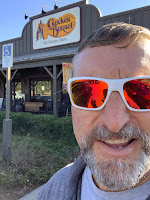You're never too old to learn new things, even despite the old adage, "You can't teach an old dog new tricks."
Having celebrated my 60th birthday just the other day, I was given pause to reflect on what I used to consider was a "ripe old age" back in my 20's. With no shots taken at anyone in my life who is well ripened, I can vividly recall being unable to wrap my head around what life would look like at that magic time of life. Well, as I was reminded, no one can stop the Wheel of Time and the face looking back at me in the mirror shows the wheel's grinding effects.
Considering I spent a 30 year career in education, I would be a rich man indeed if I had a a dollar for every time I spoke to young 'uns about becoming, and relishing in, being lifelong learners. From my perch atop the ol' soap box, I extolled the virtues of seeking a life filled with unceasing enlightenment, praising the emotional rush of learning, proving my point with benefits like increased earning potential and mental acuity.
I'd like to unequivocally state that I have 'walked the talk' throughout my life, each day featuring a conscious effort to discover something previously unknown. Being a Baby Boomer, it is easy to refer to the various generations as 'other folk', and at the risk of sounding my age, it has been a darn sight easier to be a lifelong learner in the age of the Internet. Yes, I admit that there's a lot of false facts (a previous post CLICK) that can easily charter an errant course, but that's half the fun, to me at least. As Sherlock Holmes is credited, "The game is afoot!" The finding is almost as entertaining as the proving in most cases.
Here's a sample of some recent efforts at enlightenment:
Find #1: Michelin ratings of restaurantsThe original Michelin Man became a brand ambassador in 1894. He was white because the rubber used in tires was naturally white. It was not until 1912 that carbon chemicals were mixed into the white tires, turning them black. The change was structural, not aesthetic. By adding carbon, tires became more durable, staving off the considerable investment in replacement. In a stroke of some marketer's genius, and prior to the carbon addition, the Michelin brothers began reviewing restaurants so that more people would travel further distances in their cars to eat at these restaurants, which prior to the chemical wizardry previously mentioned, would wear down their tires faster, and force them to buy more.
The first Michelin Guide was compiled in 1900 by Michelin Tire founders and French industrialist brothers Andre and Edouard Michelin. The aim of the guide was to create a demand for automobiles, and therefore, Michelin tires. Since there were only a few hundred cars in all of France, the guide was given away for free in hopes of creating demand for cars. Within its first decade of existence, the Michelin Guide expanded rapidly and became available throughout Europe, as well as Northern Africa. Although the guides contained valuable information about restaurants, the ultimate end goal for the Michelin brothers was to generate sales and profit for their tire business. (
CLICK)
The star system that Michelin created went up to three and was broken down by whether or not it's worth driving to the restaurant.
One star: "A very good restaurant in its category"
Two star: "Excellent cooking, worth a detour"
Three star: "Exceptional cuisine, worth a special journey"
A Michelin inspector's 5 restaurant rating criteria
Quality of products
Mastery of flavor and cooking techniques
The personality of the chef represented in the dining experience
Value for money
Consistency between inspectors’ visits
Find #2: Homegrown facts (
CLICK)
Toronto is home to the longest street in the world – Yonge Street, which originated in Toronto, goes almost all the way to Lake Simcoe, clocking in at 1,896 km (1,178 mi) in length. Making personal connections, I can still vividly recall my childhood trips to 'The Big Smoke' and being fascinated by the glitz and glitter of downtown Yonge Street. When my Papa used to rent a cottage in Woodland Beach for the summer, he used to drive up Yonge St from their Parkdale home, stop in Holland Landing for veggies, and arrive simply staying the weekend before retracing his route back to work on Monday. Imagine travelling TO to WB using only Yonge St now?
The beer named after Canada is called Molson Canadian. Founded in Montreal in 1786, Molson Coors Canada is the oldest brewery in North America and continues to produce beer on the site of the original brewery.Fun factoid about Molson's: I actually attended Queen's University with one of the Molson grandkids but I can't remember (or find) his name. I do recall that he was a really nice guy, friendly, happy, big smile ... Hey, if you stood to inherit millions and had access to as much beer as you could drink, his happy disposition is not at all surprising!
Moosehead Breweries Limited is Canada’s oldest independent brewery, located in Saint John, New Brunswick. The brewery was founded in 1867 and is still privately owned and operated by the Oland family. The company is now in the sixth generation of family ownership and turns out 1,642 bottles of beer per minute.
I actually never tried Moosehead beer until I was in Uni, and even then, only because we qualified for the Atlantic Bowl in FB playoffs. We travelled to NS to play UNB at St Mary's, a game that had a rather unhappy ending, I might add, and we drowned our sorrow using Moosehead. The little I can recall ... I said it was unhappy, didn't I ... was that it was pretty good beer.
Poutine has become a famous dish here in Canada and was created in Montreal, Quebec back in the 1950s. It consists of french fries and cheese curds melted in gravy.
There are two things that make me a pretty odd Canuk ... I'm not a huge hockey fan and I don't really care for poutine. I am, however, a HUGE butter tart fan so I guess things have a way of balancing out. The little lady LOVES poutine so our household does its best at keeping up the patriotic spirit!
Butter Tarts were created in Barrie, Ontario in 1900.
Like I already confessed, HUGE butter tart fan! So much so that I can rank those offered within a healthy bike ride from me with relative accuracy. Now, healthy is open to interpretation, since 200 km is not out of the realm of possible, especially for something as delicious as a great BT. Just to cure your itch, the best in this area by a very narrow margin are from the Maid's Cottage in downtown Newmarket, but more local fare includes Cheeky Mama's in Victoria Harbour for overall taste (although I think they closed recently), and Harris Farms in Minesing for best value. Honourable mentions go to the Bank Cafe in Creemore and the Belwood Farmer's Market.
Ginger Ale was invented in Toronto back in 1907. Canada Dry is famous around the world.
I don't really lean toward soda. If I do yearn for its fizzy nose burning, however, it is more often than not a Ginger Ale, so the fact that is was born in Toronto is a pure bred Canadian win.
Peanut Butter was created in Montreal back in 1884.
I will forever be indebted to Marcellus Gilmore Edson's for his patented peanut paste, the finished product from milling roasted peanuts between two heated surfaces. (
CLICK) While some credit is due to the ancient Aztecs who enjoyed a mash of roasted peanuts, the first patented process was granted to Edson in 1884. American naysayers who claim Dr John Harvey Kellogg (of Kellogg's cereals fame) as the inventor need be aware that Kellogg's patent was for making PB from raw peanuts while Edson's processing started with roasted goobers. Nice try Yankee Doodle!
Find #3: The story behind Bohemian Rhapsody The following essay has been making the rounds on Social Media lately, and its so interesting, I couldn't let a post about lifelong learning slide by without including it. I had no idea that the song I've been air-guitaring for so many years was so intricate in its design. I looked and couldn't find an author credit, so I'll simply stand and applaud with the hopes that he/she gets credit at some point.
Why is the song called 'Bohemian Rhapsody'?
Why does it last exactly 5 minutes and 55 seconds?
What is this song really about?
Why did the Queen movie premiere on October 31?
The video premiered on October 31 because the single was first heard on October 31, 1975. It's titled that way because a 'Rhapsody' is a free-form musical piece composed of different parts and themes that seem unrelated to each other. The word 'rhapsody' comes from Greek and means 'assembled parts of a song.' The word 'bohemian' refers to a region in the Czech Republic called Bohemia, where Faust, the protagonist of Goethe's work of the same name, was born. In Goethe's work, Faust was an elderly and intelligent man who knew everything except the mystery of life. Unable to comprehend it, he decides to poison himself. At that moment, church bells ring, and he goes outside. When he returns to his room, he finds a dog that transforms into a kind of man. It's the devil, Mephistopheles. He promises Faust a full life without misery in exchange for his soul. Faust agrees, rejuvenates, and becomes arrogant. He meets Gretchen and has a child. His wife and child die. Faust travels through time and space and feels powerful. When he becomes old again, he feels miserable once more. Since he didn't break the pact with the devil, angels contend for his soul.
This work is essential to understanding 'Bohemian Rhapsody.'
The song is about Freddie Mercury himself. Being a rhapsody, it has 7 different parts:
1st and 2nd acts - A Capella
3rd act - Ballad
4th act - Guitar solo
5th act - Opera
6th act - Rock
7th act - 'Coda' or final act
The song talks about a poor boy questioning if this life is real or if his distorted imagination is living another reality. He says that even if he stops living, the wind will keep blowing without his existence. So, he makes a deal with the devil and sells his soul. Upon making this decision, he rushes to tell his mother and says, "Mama, I just killed a man, put a gun against his head, pulled my trigger, now he's dead. Threw my life away. If I'm not back again this time tomorrow, carry on, carry on as if nothing really matters..."
The man he kills is himself, Freddie Mercury. If he doesn't fulfill the pact with the devil, he will die immediately. He says goodbye to his loved ones, and his mother breaks into tears, tears and desperate crying that comes from Brian May's guitar notes. Freddie, terrified, cries out, "Mama, I don't want to die," and the operatic part begins.
Freddie finds himself in an astral plane where he sees himself: "I see a little silhouetto of a man"... "Scaramouche, will you do the Fandango?" Scaramouche is an "escaramuza," a skirmish between armies with horseback riders (4 horsemen of the Apocalypse of evil fighting against the forces of good for Freddie's soul), and he continues, saying, "Thunderbolt and lightning, very, very frightening me." This phrase appears in the Bible, specifically in Job 37 when it says, "the thunder and lightning frighten me: my heart pounds in my chest." Seeing his son so scared by the decision he has made, Freddie's mother begs to save him from the pact with Mephistopheles. "He's just a poor boy..." "Spare him his life from this monstrosity." "Easy come, easy go, will you let me go?" Her pleas are heard, and angels descend to battle the forces of evil. "Bismillah" (an Arabic word meaning "In the name of God") is the first word in the holy book of Muslims, the Quran. So, God Himself appears and shouts, "We will not let you go."
In the face of such a confrontation between good and evil, Freddie fears for his mother's life and says, "Mama mia, mama mia, let me go." They shout again from the sky that they won't abandon him, and Freddie cries, "No, no, no, no, no," and says, "Beelzebub (the Lord of Darkness) has a devil put aside for me." Freddie pays homage here to Wolfgang Amadeus Mozart and Johann Sebastian Bach when he sings... "Figaro, Magnifico," referring to Mozart's "The Marriage of Figaro," considered the greatest opera of all time, and to Bach's "Magnificat."
The operatic part ends, and the rockier part bursts in. The devil, angry and betrayed by Freddie not keeping the pact, says, "So you think you can stone me and spit in my eye? So you think you can love me and leave me to die?" It's chilling how the Lord of Evil feels powerless against a human being, against repentance and love.
Having lost the battle, the devil departs, and we reach the final act or 'coda' where Freddie is free, and that feeling comforts him. The gong that closes the song sounds. The gong is an instrument used in China and East Asian cultures to heal people under the influence of evil spirits.
It lasts for 5:55 minutes. Freddie liked astrology, and in numerology, 555 is associated with death, not physical but spiritual, the end of something where angels will safeguard you. 555 is related to God and the divine, an ending that will lead to a new beginning. And the song plays on Halloween eve for the first time. A holiday called 'Samhain' by the Celts to celebrate the transition and opening to the other world. The Celts believed that the world of the living and the dead were closely connected, and on the Day of the Dead, both worlds would unite, allowing spirits to cross over.
Nothing in 'Bohemian Rhapsody' is coincidental.
Everything is carefully crafted.
Everything has a meaning that goes beyond being just a song.
It has been voted worldwide as the greatest song of all time.
If you've reached the end of this post, CONGRATULATIONS!
I sincerely apologize for its considerable length, but as the saying goes, "Good things come to those that wait!" All of these fairly useless facts ... in the grand scheme of Life ... are well worth the patience required to complete this task, and certainly left me with a profound sense of, "Huh. Who'd a thunk."
#classdismissed
#lifelonglearning
#ieducate

































